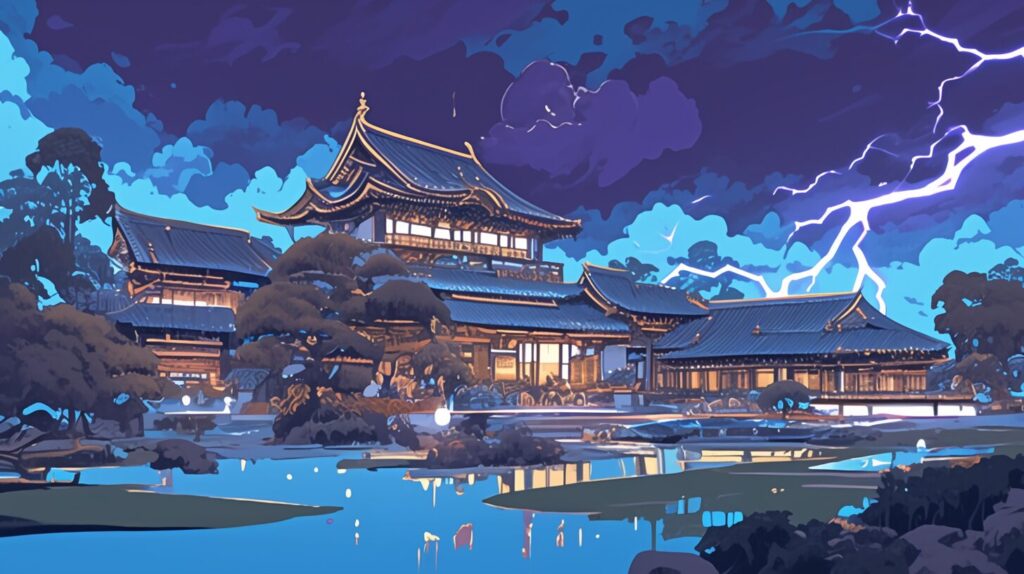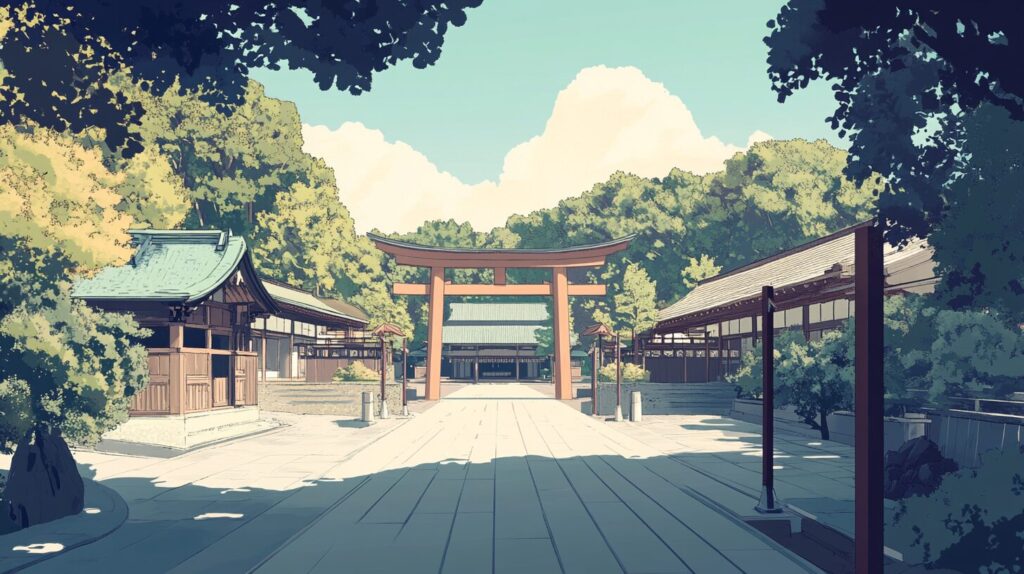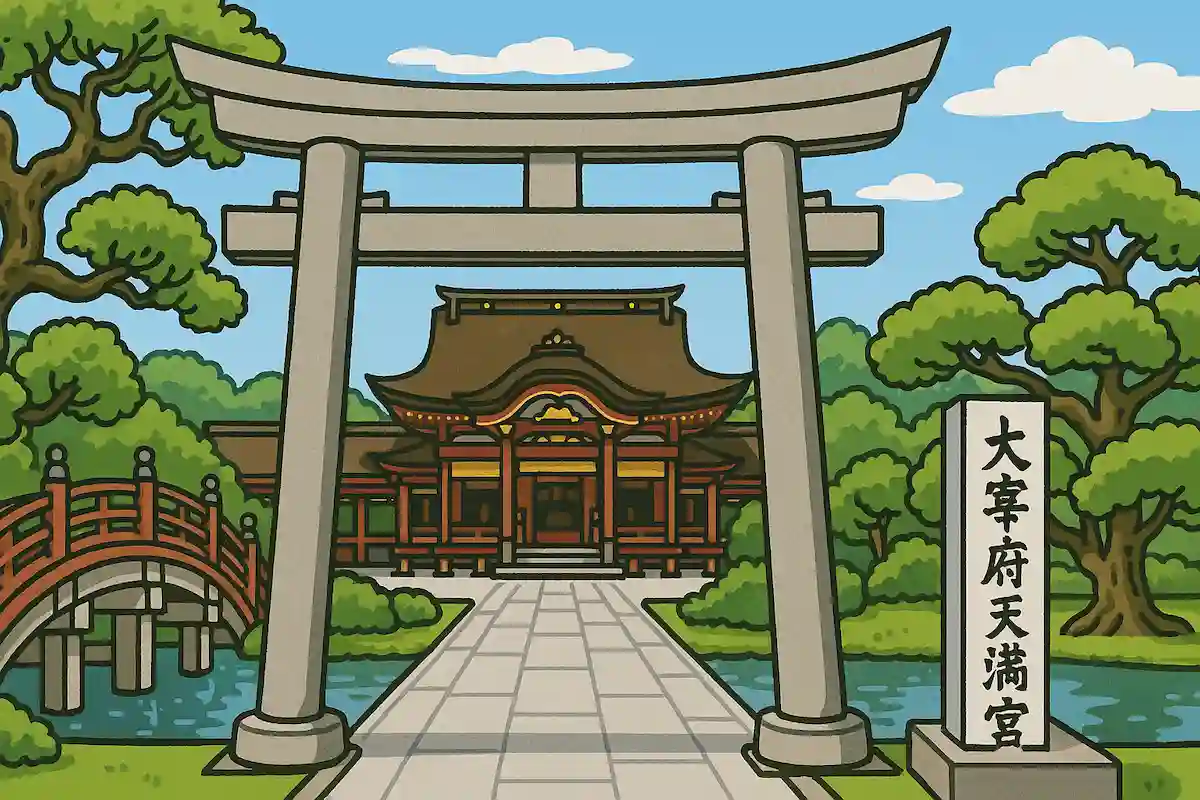菅原道真を英語で説明・紹介するための基本情報と、英会話に役立つ表現をシンプルでわかりやすい英語で紹介します。
英会話ダイアローグ・概要・10の質問を通して、菅原道真に関する英語表現を学びます。
英語
英会話ダイアローグを読む前に知っておくと良い前提知識と情報です。
- 菅原道真の基本情報
- 平安時代(9世紀)の学者・政治家・詩人
- もともとは学問の道を究めた天才的な学者だったが、後に政治家としても活躍
- 学問の神様(天神) として、死後に祀られるようになった
- 合格祈願の神社(天満宮) でよく知られる存在
- 菅原道真の生涯と業績
- 生い立ちと学者としての活躍:
- 845年、京都の学者の家系に生まれる。
- 幼いころから秀才で、22歳で「文章博士」という最高学位を取得
- 中国文学や漢詩に優れ、学者として名を馳せる
- 政治家としての活躍と失脚:
- 宇多天皇に重用され、右大臣という高い地位に就く
- 894年、遣唐使の廃止を提言し、日本の独自文化の発展に貢献
- 藤原氏の陰謀により、901年に太宰府(福岡)へ左遷される
- 太宰府での最期:
- 孤独のうちに903年に亡くなる
- しかし、彼の死後、京都で雷や疫病が相次ぎ、道真の「怨霊」の仕業と恐れられる
- 生い立ちと学者としての活躍:
- 菅原道真にまつわる伝説
- 飛梅伝説:
- 道真が太宰府に流される際に、愛していた梅の木に向けて詠んだ和歌:「東風吹かば 匂ひおこせよ 梅の花 主なしとて 春を忘るな」
- すると、その梅の木が京都から太宰府まで飛んできたという伝説がある
- 怨霊伝説と神格化:
- 道真の死後、京都では落雷や災害が続いたため、人々は彼の霊を鎮めるために北野天満宮(京都)を建てた
- これがのちに、「学問の神・天神」として信仰されるきっかけとなる
- 動かなくなった牛の伝説:
- 道真の遺体を運んでいた牛が、突然動かなくなった
- これを「この地に葬ってほしい」という道真の意思と考え、その場所に太宰府天満宮が建てられた
- そのため、天満宮では「牛」が神聖な動物とされている
- 飛梅伝説:
- 菅原道真を祀る神社(天満宮)
- 道真は死後に神格化され、日本全国に彼を祀る「天満宮」が作られた
- 受験生の合格祈願の神様として全国的に信仰されており、全国に約12,000社の天満宮がある
- 特に有名な天満宮:北野天満宮(京都)、太宰府天満宮(福岡)、大阪天満宮、亀戸天神(東京)
2人が菅原道真について話しています。
菅原道真の生い立ち、政治での活躍、太宰府への左遷、有名な伝説、彼を祀る天満宮などを話題にしています。
会話 / dialogue

Hey Key, I’ve been reading about Sugawara no Michizane lately. He seems like a really fascinating historical figure. Do you know much about him?

Oh yeah! He’s one of the most famous figures from the Heian period. He was a scholar, a politician, and later became the god of learning. What got you interested in him?

Well, I visited Kameido Tenjin Shrine the other day, and I saw students praying there. I asked about it, and they told me it’s dedicated to Sugawara no Michizane. So I wanted to learn more.

That makes sense! Students pray to him because he was a genius in literature and politics. He was born in Kyoto in 845 into a family of scholars and was extremely talented from a young age.

I heard he became Monjō Hakase, one of the highest-ranking scholarly positions in the Imperial Court, at just 22 years old.

Yes, he was an expert in Chinese literature and government studies and was also responsible for teaching future officials.

So how did he become a politician?

Emperor Uda recognized his talent and made him an important official. Eventually, he became Minister of the Right, which was one of the highest positions in the government.

Wow! He must have been really powerful.

He was, but that also made him enemies. The Fujiwara clan, which controlled the government, felt threatened by him. They spread false rumors and got him exiled to Dazaifu in 901.

That’s awful! What happened to him there?

He lived in sadness and loneliness in Dazaifu. He wrote poetry expressing his feelings. One of his most famous poems was about his beloved plum tree in Kyoto.

Oh, I think I read about that! Something about the tree flying to him?

Exactly! According to legend, his plum tree flew from Kyoto to Dazaifu because it missed him. That tree is still at Dazaifu Tenmangu Shrine, and people call it Tobiume (Flying Plum Tree).

That’s such a touching story. But he didn’t survive long after that, right?

Yeah, he passed away in 903. But after his death, strange things started happening in Kyoto—thunderstorms, lightning strikes, and sudden deaths of his political enemies.

That sounds like a ghost story!

It kind of is! People believed his angry spirit was causing these disasters. So, to calm him, the emperor built Kitano Tenmangu Shrine in Kyoto and declared him a god.

That’s incredible. So now, he’s worshiped as Tenjin, the god of learning?

Exactly! Students all over Japan visit Tenmangu shrines to pray for good grades and exam success.

I see! So besides Kitano Tenmangu and Dazaifu Tenmangu, are there other famous shrines for him?

Yes! There’s Osaka Tenmangu, and in Tokyo, the most famous one is Kameido Tenjin Shrine. That’s the one you visited!

That explains why I saw so many students there. I feel like I understand him a lot better now.

Glad to hear that! Maybe next time, we should visit Dazaifu Tenmangu together. It’s a beautiful place!

That sounds like a great idea!
概要 / Overview
「菅原道真」について、理解を深めるための「英語での概要」です。
菅原道真

Who Was Sugawara no Michizane?
Sugawara no Michizane (845–903) was a famous scholar, poet, and politician from the Heian period in Japan. He was known for his intelligence, honesty, and love for learning. Today, he is worshiped as Tenjin, the god of learning, at many shrines across Japan.
Early Life and Education
Michizane was born in Kyoto in 845 into a family of scholars. From a young age, he was very talented in Chinese literature and poetry. At just 22 years old, he became Monjō Hakase, one of the highest-ranking scholarly positions in the Imperial Court. This position meant he was responsible for teaching future government officials.
A Successful Politician
Michizane gained the trust of Emperor Uda and became a powerful government official. In 894, he stopped Japan’s missions to China (Tang Dynasty) because China was weak, and the journey was dangerous. This decision helped Japan develop its own unique culture. Later, he became Minister of the Right, one of the most important positions in the government.
Exile to Dazaifu
However, Michizane had powerful enemies. The Fujiwara clan, who controlled the government, saw him as a threat. In 901, they spread false rumors about him, and he was exiled to Dazaifu (Kyushu). He lived there in sadness and loneliness until his death in 903.
Legends After His Death
After his death, strange things happened in Kyoto—thunderstorms, lightning, and the sudden deaths of his enemies. People believed Michizane’s angry spirit was causing these disasters. To calm him, the emperor built Kitano Tenmangu Shrine in Kyoto, and he became a god of learning.
One famous story says his plum tree in Kyoto flew to Dazaifu because it missed him. This tree, called Tobiume (Flying Plum Tree), still exists at Dazaifu Tenmangu Shrine today.
Worship and Shrines
Today, Michizane is worshiped at Tenmangu shrines across Japan. The most famous ones are Kitano Tenmangu (Kyoto), Dazaifu Tenmangu (Fukuoka), and Kameido Tenjin (Tokyo). Students pray to him for success in exams.
Conclusion
Sugawara no Michizane was a brilliant scholar and loyal politician who suffered an unfair exile. His tragic story and deep love for learning made him a legendary figure in Japanese history. Today, he is remembered as the god of learning, inspiring students across Japan.
10の質問 / 10 questions
「菅原道真」について、理解を深めるための「英語での10の質問」です。
1: What was Sugawara no Michizane known for?
Sugawara no Michizane was a renowned Japanese scholar, poet, and politician during the Heian period. He is especially remembered for his expertise in Chinese literature and his significant contributions to Japanese politics.
2: When and where was Sugawara no Michizane born?
He was born in 845 in Kyoto, Japan.
3: What role did he achieve at the age of 22?
At 22, Michizane became Monjō Hakase, a top scholarly position in the Imperial Court, responsible for educating future government officials.
4: Why was he exiled to Dazaifu?
Due to political rivalries, particularly with the Fujiwara clan, false accusations led to his exile to Dazaifu in 901.
5: How did Michizane’s life end?
He lived in Dazaifu until his death in 903, spending his final years in isolation and sorrow.
6: What events occurred after his death that affected his legacy?
After his death, Kyoto experienced natural disasters, which people believed were caused by Michizane’s angry spirit. To appease him, the emperor built Kitano Tenmangu Shrine in Kyoto.
7: What is the significance of the plum tree in Michizane’s story?
A legend tells that Michizane’s beloved plum tree in Kyoto flew to Dazaifu to be with him. This “Flying Plum Tree” is still at Dazaifu Tenmangu Shrine today.
8: How is Sugawara no Michizane honored in Japan today?
He is worshiped as Tenjin, the god of learning, and many shrines across Japan are dedicated to him, including Kitano Tenmangu in Kyoto and Dazaifu Tenmangu in Fukuoka.
9: Why do students pray to Sugawara no Michizane?
Students pray to him for success in their studies and exams, seeking his blessing as the god of learning.
10: What are Tenmangu shrines?
Tenmangu shrines are Shinto shrines dedicated to Sugawara no Michizane, where people, especially students, go to pray for academic success.

和訳付
会話 / dialogue

Hey Key, I’ve been reading about Sugawara no Michizane lately. He seems like a really fascinating historical figure. Do you know much about him?
ねえキー、最近菅原道真について読んでるんだけど、すごく興味深い歴史上の人物みたいだよね。彼について詳しい?

Oh yeah! He’s one of the most famous figures from the Heian period. He was a scholar, a politician, and later became the god of learning. What got you interested in him?
もちろん!彼は平安時代で最も有名な人物の一人だよ。学者であり、政治家でもあって、後には学問の神様になったんだ。どうして興味を持ったの?

Well, I visited Kameido Tenjin Shrine the other day, and I saw students praying there. I asked about it, and they told me it’s dedicated to Sugawara no Michizane. So I wanted to learn more.
こないだ亀戸天神社に行ったんだけど、学生たちが祈っているのを見たんだ。それで聞いてみたら、菅原道真を祀っている神社だって教えてもらって、もっと知りたくなったんだよ。

That makes sense! Students pray to him because he was a genius in literature and politics. He was born in Kyoto in 845 into a family of scholars and was extremely talented from a young age.
なるほどね!学生たちが祈るのは、道真が文学と政治の天才だったからだよ。彼は845年に京都の学者の家系に生まれて、幼い頃からすごく才能があったんだ。

I heard he became Monjō Hakase, one of the highest-ranking scholarly positions in the Imperial Court, at just 22 years old.
22歳で文章博士っていう、宮廷で最高レベルの学者の地位についたって聞いたよ。

Yes, he was an expert in Chinese literature and government studies and was also responsible for teaching future officials.
そうだよ。彼は中国文学や政治の専門家だったし、将来の官僚たちを教育する役目も担っていたんだ。

So how did he become a politician?
それで、どうやって政治家になったの?

Emperor Uda recognized his talent and made him an important official. Eventually, he became Minister of the Right, which was one of the highest positions in the government.
宇多天皇が彼の才能を認めて、重要な官僚にしたんだ。最終的には右大臣になったんだけど、それは当時の政府でトップクラスの地位だったんだよ。

Wow! He must have been really powerful.
すごいね!かなりの権力を持っていたんだね。

He was, but that also made him enemies. The Fujiwara clan, which controlled the government, felt threatened by him. They spread false rumors and got him exiled to Dazaifu in 901.
そうなんだけど、それが原因で敵もできたんだ。藤原氏っていう当時の権力者たちが、彼を脅威に感じてね。嘘の噂を流して、901年に彼を太宰府に左遷させたんだ。

That’s awful! What happened to him there?
ひどい話だね!太宰府ではどうなったの?

He lived in sadness and loneliness in Dazaifu. He wrote poetry expressing his feelings. One of his most famous poems was about his beloved plum tree in Kyoto.
彼は太宰府で寂しく、悲しい日々を過ごしたよ。その気持ちを詩に表現していたんだ。特に有名なのは、京都にあった大好きな梅の木について詠んだ詩だね。

Oh, I think I read about that! Something about the tree flying to him?
あ、それ読んだことあるかも!梅の木が彼のもとに飛んでいったって話でしょ?

Exactly! According to legend, his plum tree flew from Kyoto to Dazaifu because it missed him. That tree is still at Dazaifu Tenmangu Shrine, and people call it Tobiume (Flying Plum Tree).
その通り!伝説では、彼を慕って梅の木が京都から太宰府まで飛んできたんだって。今でもその木は太宰府天満宮にあって、「飛梅(とびうめ)」って呼ばれているんだよ。

That’s such a touching story. But he didn’t survive long after that, right?
感動的な話だね。でも、その後あまり長く生きられなかったんでしょ?

Yeah, he passed away in 903. But after his death, strange things started happening in Kyoto—thunderstorms, lightning strikes, and sudden deaths of his political enemies.
そう、903年に亡くなったよ。でも彼の死後、京都で不思議なことが起こり始めたんだ。雷が落ちたり、彼を陥れた人たちが急に亡くなったりしてね。

That sounds like a ghost story!
まるで幽霊の話みたいだね!

It kind of is! People believed his angry spirit was causing these disasters. So, to calm him, the emperor built Kitano Tenmangu Shrine in Kyoto and declared him a god.
そうなんだよ!人々は、彼の怒った霊が災いを起こしているって思ったんだ。それで天皇が彼を鎮めるために京都に北野天満宮を建てて、神として祀ることにしたんだよ。

That’s incredible. So now, he’s worshiped as Tenjin, the god of learning?
すごい話だね。つまり、今では学問の神「天神」として崇められているんだ?

Exactly! Students all over Japan visit Tenmangu shrines to pray for good grades and exam success.
その通り!日本中の学生が天満宮に行って、成績向上や試験の合格を祈ってるよ。

I see! So besides Kitano Tenmangu and Dazaifu Tenmangu, are there other famous shrines for him?
なるほど!じゃあ、北野天満宮と太宰府天満宮以外にも、有名な神社はあるの?

Yes! There’s Osaka Tenmangu, and in Tokyo, the most famous one is Kameido Tenjin Shrine. That’s the one you visited!
あるよ!大阪天満宮も有名だし、東京だと一番有名なのが亀戸天神社だね。マックが行ったのがそこだよ!

That explains why I saw so many students there. I feel like I understand him a lot better now.だからあんなに学生がいたんだね!なんか、道真についてすごくよく分かったよ。

Glad to hear that! Maybe next time, we should visit Dazaifu Tenmangu together. It’s a beautiful place!それはよかった!今度、太宰府天満宮に一緒に行ってみようよ。すごく綺麗なところだよ!

That sounds like a great idea!それ、いいね!
概要 / Overview
菅原道真

Who Was Sugawara no Michizane?
Sugawara no Michizane (845–903) was a famous scholar, poet, and politician from the Heian period in Japan. He was known for his intelligence, honesty, and love for learning. Today, he is worshiped as Tenjin, the god of learning, at many shrines across Japan.
菅原道真とは?
菅原道真(845–903)は、平安時代の学者・詩人・政治家 でした。彼は知性、誠実さ、学問への愛 で知られています。現在、日本全国の神社で学問の神「天神」 として祀られています。
Early Life and Education
Michizane was born in Kyoto in 845 into a family of scholars. From a young age, he was very talented in Chinese literature and poetry. At just 22 years old, he became Monjō Hakase, one of the highest-ranking scholarly positions in the Imperial Court. This position meant he was responsible for teaching future government officials.
幼少期と教育
道真は845年に京都で 学者の家系に生まれました。幼い頃から中国文学や詩 に優れた才能を持っていました。22歳のとき、彼は文章博士(もんじょうはかせ) という宮廷で最高レベルの学者の地位に就きました。この役職では、将来の官僚を教育する責任 も担っていました。
A Successful Politician
Michizane gained the trust of Emperor Uda and became a powerful government official. In 894, he stopped Japan’s missions to China (Tang Dynasty) because China was weak, and the journey was dangerous. This decision helped Japan develop its own unique culture. Later, he became Minister of the Right, one of the most important positions in the government.
政治家としての成功
道真は宇多天皇 の信頼を得て、重要な政府高官となりました。894年、彼は遣唐使(中国・唐王朝への外交使節)を廃止 しました。当時の中国は衰退し、旅が危険だったためです。この決定は、日本が独自の文化を発展させる きっかけとなりました。その後、彼は右大臣 に任命され、政府で最も重要な地位の一つを占めました。
Exile to Dazaifu
However, Michizane had powerful enemies. The Fujiwara clan, who controlled the government, saw him as a threat. In 901, they spread false rumors about him, and he was exiled to Dazaifu (Kyushu). He lived there in sadness and loneliness until his death in 903.
太宰府への左遷
しかし、道真には強力な敵 もいました。当時、政府を支配していた藤原氏 は、彼の存在を脅威に感じました。901年、藤原氏は偽の噂 を広め、道真を九州・太宰府へ左遷 しました。彼はそこで孤独と悲しみの中で生活し、903年に亡くなりました。
Legends After His Death
After his death, strange things happened in Kyoto—thunderstorms, lightning, and the sudden deaths of his enemies. People believed Michizane’s angry spirit was causing these disasters. To calm him, the emperor built Kitano Tenmangu Shrine in Kyoto, and he became a god of learning.
One famous story says his plum tree in Kyoto flew to Dazaifu because it missed him. This tree, called Tobiume (Flying Plum Tree), still exists at Dazaifu Tenmangu Shrine today.
死後の伝説
道真の死後、京都では雷雨や落雷、彼の敵の突然の死 など、不思議な出来事が相次ぎました。人々はこれを、道真の怒れる霊 の仕業だと考えました。そこで天皇は彼を鎮めるために、京都に北野天満宮 を建立し、道真は学問の神 として祀られるようになりました。
また、有名な伝説として、彼の京都の梅の木が、道真を慕って太宰府へ飛んで行った という話があります。この梅の木は「飛梅(とびうめ)」 と呼ばれ、現在も太宰府天満宮 に残っています。
Worship and Shrines
Today, Michizane is worshiped at Tenmangu shrines across Japan. The most famous ones are Kitano Tenmangu (Kyoto), Dazaifu Tenmangu (Fukuoka), and Kameido Tenjin (Tokyo). Students pray to him for success in exams.
祀られる神社
現在、日本全国の天満宮 で道真は祀られています。特に有名なのは、京都の北野天満宮、福岡の太宰府天満宮、東京の亀戸天神社 です。学生たちは、試験合格や学業成就を祈願 するために訪れます。
Conclusion
Sugawara no Michizane was a brilliant scholar and loyal politician who suffered an unfair exile. His tragic story and deep love for learning made him a legendary figure in Japanese history. Today, he is remembered as the god of learning, inspiring students across Japan.
まとめ
菅原道真は、優れた学者であり、忠誠心のある政治家 でしたが、不当な左遷という悲劇に見舞われました。しかし、その学問への情熱と伝説 により、日本の歴史に残る伝説的な人物 となりました。現在でも学問の神 として崇められ、日本中の学生たちに影響を与え続けています。
10の質問 / 10 questions
1: What was Sugawara no Michizane known for?
菅原道真は何で有名でしたか?
Sugawara no Michizane was a renowned Japanese scholar, poet, and politician during the Heian period. He is especially remembered for his expertise in Chinese literature and his significant contributions to Japanese politics.
菅原道真は、平安時代の有名な学者、詩人、政治家でした。特に中国文学の専門知識と、日本の政治への重要な貢献で知られています。
2: When and where was Sugawara no Michizane born?
菅原道真はいつ、どこで生まれましたか?
He was born in 845 in Kyoto, Japan.
彼は845年に日本の京都で生まれました。
3: What role did he achieve at the age of 22?
彼は22歳でどのような地位に就きましたか?
At 22, Michizane became Monjō Hakase, a top scholarly position in the Imperial Court, responsible for educating future government officials.
22歳で道真は文章博士になりました。これは宮廷の最高学者の地位であり、将来の政府官僚を教育する役割を担っていました。
4: Why was he exiled to Dazaifu?
彼はなぜ太宰府に流されたのですか?
Due to political rivalries, particularly with the Fujiwara clan, false accusations led to his exile to Dazaifu in 901.
政治的な対立、特に藤原氏との対立により、虚偽の告発を受け、901年に太宰府へ流されました。
5: How did Michizane’s life end?
道真はどのように生涯を終えましたか?
He lived in Dazaifu until his death in 903, spending his final years in isolation and sorrow.
彼は903年に亡くなるまで太宰府で過ごし、最後の数年間は孤独と悲しみの中で暮らしました。
6: What events occurred after his death that affected his legacy?
彼の死後、彼の名声に影響を与えた出来事は何ですか?
After his death, Kyoto experienced natural disasters, which people believed were caused by Michizane’s angry spirit. To appease him, the emperor built Kitano Tenmangu Shrine in Kyoto.
彼の死後、京都で自然災害が発生し、人々はそれを道真の怒れる霊の仕業だと考えました。彼を鎮めるため、天皇は京都に北野天満宮を建立しました。
7: What is the significance of the plum tree in Michizane’s story?
道真の物語における梅の木の意味は何ですか?
A legend tells that Michizane’s beloved plum tree in Kyoto flew to Dazaifu to be with him. This “Flying Plum Tree” is still at Dazaifu Tenmangu Shrine today.
伝説によると、道真が愛した京都の梅の木が彼を慕い、太宰府まで飛んで行ったとされています。この「飛梅」は現在も太宰府天満宮に残っています。
8: How is Sugawara no Michizane honored in Japan today?
現在、日本では菅原道真はどのように崇拝されていますか?
He is worshiped as Tenjin, the god of learning, and many shrines across Japan are dedicated to him, including Kitano Tenmangu in Kyoto and Dazaifu Tenmangu in Fukuoka.
彼は学問の神「天神」として崇拝されており、京都の北野天満宮や福岡の太宰府天満宮をはじめ、日本各地の神社に祀られています。
9: Why do students pray to Sugawara no Michizane?
なぜ学生は菅原道真に祈るのですか?
Students pray to him for success in their studies and exams, seeking his blessing as the god of learning.
学生たちは学問の神としての加護を求め、試験や勉強の成功を祈願します。
10: What are Tenmangu shrines?
天満宮とは何ですか?
Tenmangu shrines are Shinto shrines dedicated to Sugawara no Michizane, where people, especially students, go to pray for academic success.
天満宮は菅原道真を祀る神社であり、特に学生が学業成就を願って参拝する場所です。

words & phrases
英会話ダイアローグと関連情報に出てきた単語・フレーズです(例文は各3つ)。

dedicated : 形容詞
意味: ある特定の目的や人物に捧げられた、または熱心で献身的なこと。Devoted to a particular purpose, cause, or person.
(菅原道真を祀る神社は、彼に「dedicated」されている)
例文:
- This shrine is dedicated to Sugawara no Michizane.
「この神社は菅原道真を祀っています。」 - She is a dedicated teacher who cares deeply about her students.
「彼女は生徒を大切にする熱心な教師です。」 - The book is dedicated to my parents.
「この本は私の両親に捧げられています。」
pray : 動詞
意味: 神や高次の存在に願うこと。To speak to a god or higher power, often to ask for help or guidance.
(学生たちは試験の成功を願って菅原道真に「pray」する)
例文:
- Students pray to Sugawara no Michizane for academic success.
「学生たちは学業成就のために菅原道真に祈ります。」 - Let’s pray for good weather tomorrow.
「明日の天気が良くなるように祈りましょう。」 - She prayed to God for strength.
「彼女は神に力を求めて祈りました。」
talented : 形容詞
意味: 生まれつき優れた能力や才能を持つこと。Having a natural ability or skill in something.
(菅原道真は幼い頃から「talented」で、学問や詩に優れていた)
例文:
- Sugawara no Michizane was a talented scholar and poet.
「菅原道真は才能ある学者であり詩人でした。」 - She is talented in music.
「彼女は音楽の才能があります。」 - The company hired many talented young people.
「その会社は多くの才能ある若者を採用しました。」
scholarly : 形容詞
意味: 学問的な、学者らしい。Relating to serious academic study or a scholar.
(菅原道真は「scholarly」な人物で、文章博士として宮廷で働いた)
例文:
- He wrote a scholarly article on Japanese history.
「彼は日本の歴史についての学術論文を書いた。」 - Sugawara no Michizane had a scholarly mind from a young age.
「菅原道真は幼い頃から学問に優れていた。」 - The professor gave a scholarly lecture on ancient poetry.
「その教授は古代詩についての学問的な講義を行った。」
exile : 名詞・動詞
意味: (名詞)国外追放、流刑。(動詞)追放する、流す。The state of being forced to leave one’s country or home; to force someone to leave.
(菅原道真は藤原氏の陰謀により太宰府に「exile」された)
例文:
- Sugawara no Michizane was sent into exile in Dazaifu.
「菅原道真は太宰府に流刑された。」 - The king lived in exile after the revolution.
「その王は革命後、亡命生活を送った。」 - The government exiled the political leader.
「政府はその政治指導者を追放した。」
詳細情報 / Further Info
関連記事(太宰府天満宮、天神祭、亀戸天神と藤まつり)



